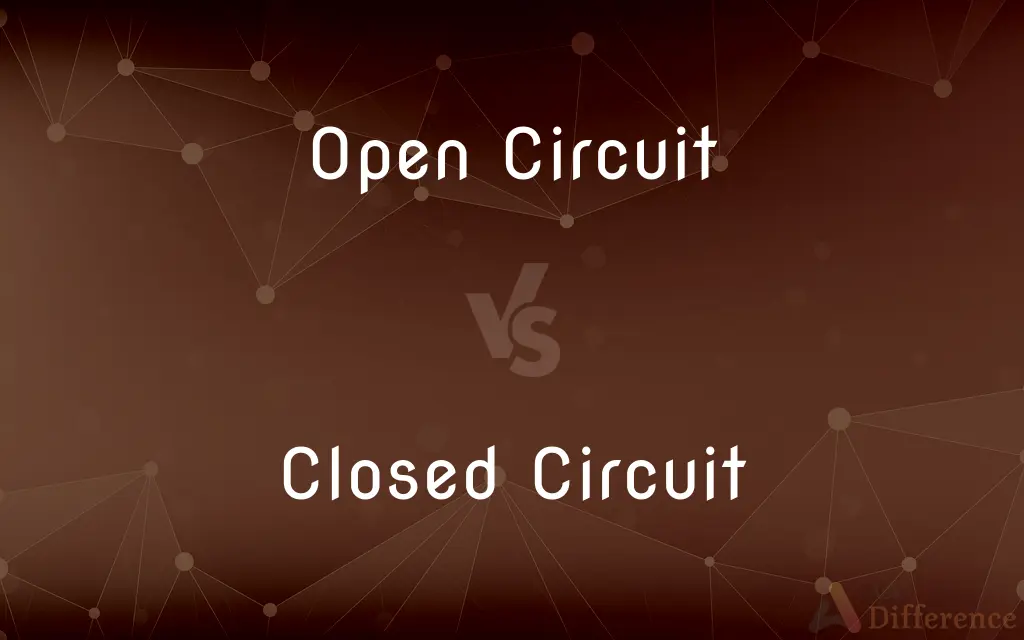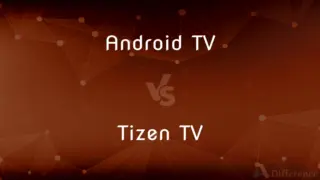Open Circuit vs. Closed Circuit — What's the Difference?
By Tayyaba Rehman — Published on January 22, 2024
Open Circuit is an electrical circuit that is not complete, thus no current flows. Closed Circuit is an electrical circuit that is complete, allowing current to flow.

Difference Between Open Circuit and Closed Circuit
Table of Contents
ADVERTISEMENT
Key Differences
An Open Circuit is characterized by a break or gap in the conducting path, preventing the flow of electric current. Conversely, a Closed Circuit has a complete path for current to flow. In an Open Circuit, the electrons cannot move across the gap, whereas in a Closed Circuit, electrons move freely through the complete circuit.
In an Open Circuit, the electrical components are disconnected in such a way that electricity cannot flow. On the other hand, in a Closed Circuit, components are connected in a loop, ensuring the continuous flow of electricity. Open Circuits are often a result of intentional switches or accidental breaks, while Closed Circuits represent the normal operation of electronic devices.
The key difference between an Open and Closed Circuit is in their functionality. Open Circuits are non-functional, as no electrical task can be completed without a closed loop. In contrast, Closed Circuits are functional and essential for operating any electrical appliance.
Diagnostically, an Open Circuit indicates a fault in the electrical system, requiring repair for the device to work. In contrast, a Closed Circuit typically indicates that the electrical system is in good condition. In troubleshooting, identifying whether a circuit is open or closed is crucial.
From a safety perspective, an Open Circuit is generally safer as it prevents the flow of electric current. However, Closed Circuits can pose hazards if not properly managed or if there is a risk of short-circuiting, which can occur when the current finds a shorter path to flow, bypassing the intended circuit.
ADVERTISEMENT
Comparison Chart
Current Flow
No current flows
Current flows
Circuit Completion
Incomplete
Complete
Functionality
Non-functional
Functional
Safety
Generally safer
Can pose hazards
Diagnostic Indication
Indicates fault
Indicates normal operation
Compare with Definitions
Open Circuit
An Open Circuit is an incomplete electrical path.
The lamp did not light up because there was an open circuit in the wiring.
Closed Circuit
A Closed Circuit is a complete electrical loop with no breaks.
The light bulb glows when the switch closes the circuit, creating a closed circuit.
Open Circuit
It is a state where electrical components are not connected end-to-end.
The switch creates an open circuit when turned off, disconnecting the power.
Closed Circuit
A Closed Circuit ensures continuous flow of electrons.
The motor runs as long as it is part of a closed circuit.
Open Circuit
It refers to a circuit where the electron flow is interrupted.
During a power outage, the circuit becomes an open circuit.
Closed Circuit
It is a condition where the electrical path is uninterrupted.
The fan operates on a closed circuit that allows continuous current flow.
Open Circuit
An Open Circuit occurs when there is a break in the conducting material.
The broken wire led to an open circuit, stopping the flow of electricity.
Closed Circuit
In a Closed Circuit, all components are connected to form a loop.
A closed circuit in the alarm system ensures its operational readiness.
Open Circuit
An Open Circuit happens when the continuity of the circuit is disrupted.
A blown fuse results in an open circuit, preventing current flow.
Closed Circuit
It refers to a circuit where electricity flows unobstructed.
The closed circuit in the heater allows it to warm the room efficiently.
Closed Circuit
An electric circuit providing an uninterrupted, endless path for the flow of current.
Closed Circuit
A television transmission circuit with a limited number of reception stations and no broadcast facilities.
Closed Circuit
That consists of a closed circuit
Closed Circuit
Relating to or consisting of a closed circuit;
Closed-circuit television
Common Curiosities
Do all electrical devices use Closed Circuits?
Yes, for an electrical device to function, it must have a Closed Circuit to allow the flow of electricity.
Can an Open Circuit be intentional?
Yes, switches are used to create Open Circuits intentionally to control the flow of electricity.
What happens when you close a switch in a circuit?
Closing a switch in a circuit completes the loop, changing an Open Circuit to a Closed Circuit, allowing current to flow.
What is the role of a fuse in a circuit?
A fuse protects a circuit. It creates an Open Circuit when excess current flows, preventing damage or hazards.
How can you identify an Open Circuit?
An Open Circuit can be identified by the absence of current flow, using tools like a multimeter.
How does a circuit breaker relate to Open and Closed Circuits?
A circuit breaker creates an Open Circuit to protect against overload or short-circuit conditions.
Can a Closed Circuit become dangerous?
Yes, if not properly managed or if there is a short-circuit, a Closed Circuit can become hazardous due to overheating or electrical fires.
What is an example of a natural Open Circuit?
A lightning rod not being struck by lightning is an example of a natural Open Circuit.
What causes an Open Circuit?
An Open Circuit is caused by a break or disconnection in the conducting path, such as a cut wire or an open switch.
Is an Open Circuit always visible?
Not always. Some Open Circuits, like a broken wire inside insulation, may not be visibly detectable.
Can a Closed Circuit exist without a power source?
No, a Closed Circuit requires a power source to drive the current flow.
Does a battery in a circuit always mean it's closed?
No, even with a battery, if there's a gap or disconnection, the circuit remains open.
Is a bulb not lighting up always an indication of an Open Circuit?
Often yes, but it could also be due to a faulty bulb or other issues in the circuit.
Do Open Circuits consume power?
No, Open Circuits do not consume power as no current flows through them.
Can a Closed Circuit have multiple paths for current?
Yes, in parallel circuits, there are multiple paths for the current to flow within a Closed Circuit.
Share Your Discovery

Previous Comparison
Android TV vs. Tizen TV
Next Comparison
Pound vs. KgAuthor Spotlight
Written by
Tayyaba RehmanTayyaba Rehman is a distinguished writer, currently serving as a primary contributor to askdifference.com. As a researcher in semantics and etymology, Tayyaba's passion for the complexity of languages and their distinctions has found a perfect home on the platform. Tayyaba delves into the intricacies of language, distinguishing between commonly confused words and phrases, thereby providing clarity for readers worldwide.
















































